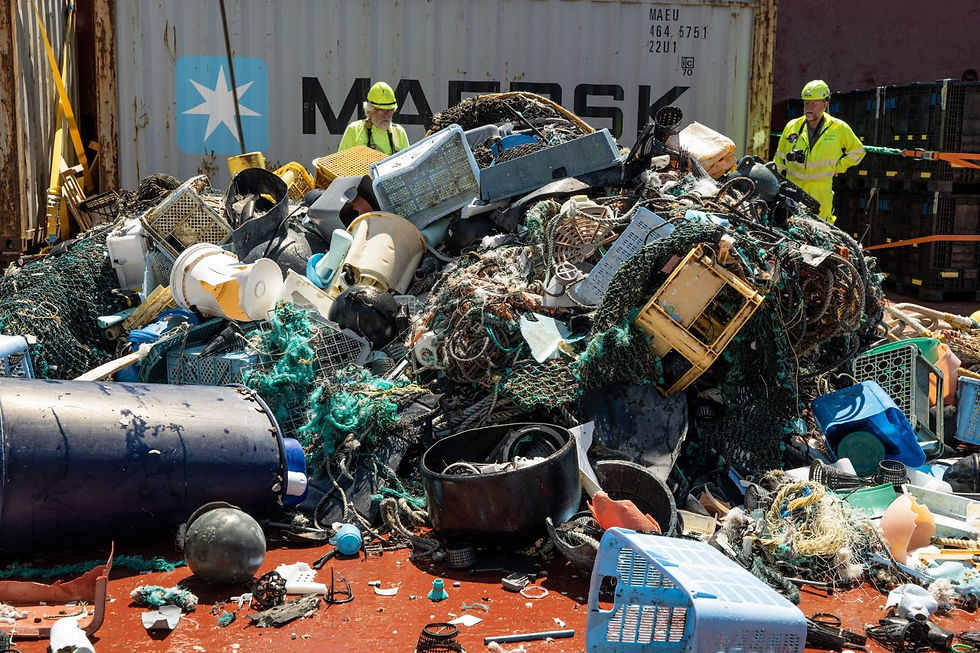The Ocean Cleanup: From System 002 to 003
- Ye Jeong Kim
- Apr 30, 2022
- 3 min read

The non-profit organization Ocean Cleanup’s mission is to develop and scale technologies to rid the world’s oceans of plastic. After finalizing its trials, it has proven technology for the ocean "operations" and can now focus on scaling up from System 002 toward a system that is three times the size and that will serve as the blueprint for further scale-up: System 03. Meanwhile, the Ocean Cleanup will keep System 002 operational until it is replaced next year, in order to maximize the data and the impact.
In the five months since it started the campaign with System 002 (a.k.a. Jenny), it reported 40,273kg plastic collected (or 1/2500th of the Great Pacific Garbage Patch). Effects on marine life were more negligible than expected in the initial assessment published in July 2021, but it observes that winter conditions have negatively affected cleanup efficiency.
Jenny sustained some wear-and-tear damage in the rougher conditions. This resulted in downtime to conduct required repairs, with a need for partial recovery of the system – waiting for weather windows to make these recoveries also caused a loss of operational time. The recorded towing forces on the cleanup system align with the computer simulations.
During the campaign, the organization continued to collect data to further improve its understanding of plastic behavior and system performance, which are all fed into the design work for System 03. It also uses the data on plastic behavior in its models for hotspot forecasting, which helps it to determine where to navigate in order to optimize catch efficiency.
"We have observed significant variations in the amount of plastic harvested per unit of time, which underlines that optimized routing of the cleanup systems will strongly influence how many will be required to clean up the patch".
ENVIRONMENTAL IMPACT: MITIGATION AND OBSERVATION
In order to operate System 002 safely in the ocean environment, the Ocean Cleanup (OC) introduced a combination of mitigation measures. First, it tows at extremely low speeds (0.5 to 1.5 knots), while having an escape route at the bottom of the retention zone. The organization has noticed that thousands of fish that enter while the system moves forward have been safely exiting through this opening. The system also provides visual cues to marine life so that it can safely avoid or navigate the system using brightly colored materials and flashing lights. The addition of audio deterrents further enhances the detectability of the system.
PROTECTED SPECIES OBSERVATIONS
Over the entire campaign, the Ocean Cleanup observed several protected species, ranging from whales and dolphins to sunfish (Mola mola), turtles, and sea lions. On two occasions, it saw a need to intervene.
One sea turtle was spotted trapped in a ghost net. The crew brought the distressed animal on board to free her from the net and safely put her back in the water. On another occasion, they noticed a sea turtle caught in a pocket between the outer and inner mesh of the retention zone. The crew freed the turtle and took it on board for observation. The animal had been able to get between the mesh layers through an unintended gap that the organization could close while at sea, mitigating this risk for the future. After confirming the animal was uninjured and in good health, the crew released it back to the ocean, away from the system and the towing vessels.
They were harshly reminded of the urgency of ocean plastic pollution when the crew found two dead juvenile loggerhead turtles among the extracted plastic. During the autopsy, the PSOs detected a significant number of plastic fragments – ranging in size from 2mm to ~30mm – all along the digestive tract of both turtles, along with a more than 200mm-long piece of monofilament fishing line in the smaller animal’s intestines. Possibly, both animals died due to extensive exposure to ocean plastic. The organization's in-house marine biologists will be working with renowned sea turtle specialists for an in-depth review of their findings.
NEXT STEPS
Based on the organization's evaluation of the first months, it has concluded that "we – by taking the aforementioned precautions – can confidently and carefully carry through with the System 002 campaign and keep learning by doing. We face an exciting journey toward upcoming milestones, with the development, launch, and deployment of System 03 later in the year".



Comments